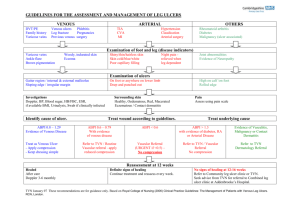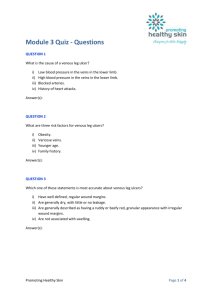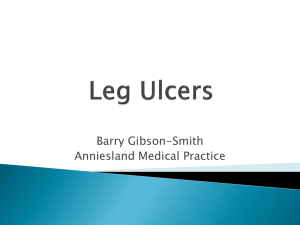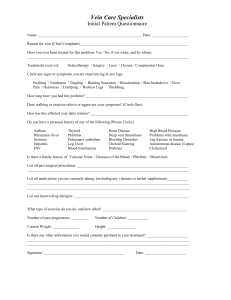SIGN
advertisement
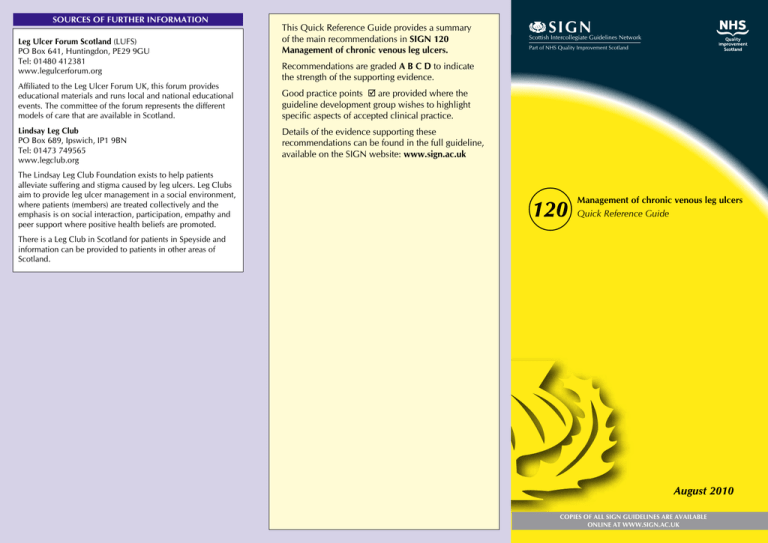
SOURCES OF FURTHER INFORMATION Leg Ulcer Forum Scotland (LUFS) PO Box 641, Huntingdon, PE29 9GU Tel: 01480 412381 www.legulcerforum.org Affiliated to the Leg Ulcer Forum UK, this forum provides educational materials and runs local and national educational events. The committee of the forum represents the different models of care that are available in Scotland. Lindsay Leg Club PO Box 689, Ipswich, IP1 9BN Tel: 01473 749565 www.legclub.org The Lindsay Leg Club Foundation exists to help patients alleviate suffering and stigma caused by leg ulcers. Leg Clubs aim to provide leg ulcer management in a social environment, where patients (members) are treated collectively and the emphasis is on social interaction, participation, empathy and peer support where positive health beliefs are promoted. This Quick Reference Guide provides a summary of the main recommendations in SIGN 120 Management of chronic venous leg ulcers. SIGN Scottish Intercollegiate Guidelines Network Part of NHS Quality Improvement Scotland Recommendations are graded A B C D to indicate the strength of the supporting evidence. Good practice points are provided where the guideline development group wishes to highlight specific aspects of accepted clinical practice. Details of the evidence supporting these recommendations can be found in the full guideline, available on the SIGN website: www.sign.ac.uk 120 Management of chronic venous leg ulcers Quick Reference Guide There is a Leg Club in Scotland for patients in Speyside and information can be provided to patients in other areas of Scotland. August 2010 COPIES OF ALL SIGN GUIDELINES ARE AVAILABLE ONLINE AT WWW.SIGN.AC.UK ASSESSMENT TREATMENT Clinical description of the ulcer Cleansing and debridement C The surface area of the ulcer should be measured serially over time. The ulcer edge often gives a good indication of progress and should be carefully documented (eg shallow, epithelialising, punched out). The base of the ulcer should be described (eg granulating, posterior, or a combination, should be clearly described. Biopsy Ulcerated legs should be washed normally in tap water and carefully dried. C Local anaesthetic cream (EMLA®) should be used to reduce the pain of sharp debridement in patients with venous leg ulcer. Dressings and topical treatments A Honey dressings are not recommended in the routine treatment of patients with venous leg ulcers. Bacteriological swabs A Silver dressings are not recommended in the routine treatment of patients with venous leg ulcers. Routine long term use of topical antiseptics and antimicrobials is not recommended. C Bacteriological swabs should only be taken where there is clinical evidence of infection. Dermatitis/eczema D Leg ulcer patients with dermatitis/eczema should be considered for patch-testing using a leg ulcer series. Vascular assessment All patients with chronic venous leg ulcer should have an ankle brachial pressure index (ABPI) performed prior to treatment. D Measurement of ankle brachial pressure index should be performed by appropriately trained practitioners who should endeavour to maintain their skills. D Compression therapy may be safely used in leg ulcer patients with ABPI≥0.8. D Patients with an ABPI of <0.8 should be referred for a cardiovascular risk factors treated according to the SIGN guideline on management of peripheral arterial disease (SIGN 89) Pulse oximetry is not routinely recommended, but may be a useful adjunctive investigative tool in specialist leg ulcer clinics. Latex-free brands of compression bandages should be used routinely. Compression should only be applied by staff with appropriate training and in accordance with the manufacturer’s instructions. REFERRAL Criteria for specialist referral D Patients who have the following features should be referred to the appropriate specialist at an early stage of management: suspicion of malignancy peripheral arterial disease (ABPI <0.8) diabetes mellitus rheumatoid arthritis/vasculitis atypical distribution of ulcers suspected contact dermatitis or dermatitis resistant to topical steroids non-healing ulcer. Compression therapy A High compression multicomponent bandaging should be routinely used for the treatment of venous leg ulcers. Patients should be offered the strongest compression that maintains patient concordance. At initiation of compression, patients should be assessed for skin complications within 24-48 hours. In patients with an ABPI <0.8, and in patients with diabetes, compression should only be used under specialist advice and with close monitoring. Systemic therapy C specialist vascular assessment. Patients with an abnormal ABPI should have their Simple non-adherent dressings are recommended in the management of venous leg ulcers. B A In patients with chronic venous leg ulcers, systemic antibiotics should not be used unless there is evidence of clinical infection. Use of pentoxifylline (400 mg three times daily for up to six months) to improve healing should be considered in patients with venous leg ulcers. Exercise Supervised calf muscle exercise should be considered in patients with venous leg ulcer PREVENTION OF ULCER RECURRENCE Compression therapy A Below-knee graduated compression hosiery is recommended to prevent recurrence of venous leg ulcer in patients where leg ulcer healing has been achieved. Patients should be offered the strongest compression which they can tolerate to prevent ulcer recurrence. Patients should be informed that it is likely that compression will be required indefinitely. The concepts, practice, and hazards of graduated compression should be fully understood by those prescribing and fitting compression stockings Venous surgery B Patients with chronic venous leg ulcer and superficial venous reflux should be considered for superficial venous surgery to prevent recurrence Assessment of venous reflux should be undertaken using duplex ultrasound. Provision of care B Specialist leg ulcer clinics are recommended as the optimal service for community treatment of venous leg ulcer. When considering the type of compression to use, practitioners should take into account: patient preference, lifestyle and likely concordance required frequency of application practitioner level of expertise size and shape of leg. appropriately trained practitioners. D Patients with a non-healing or atypical leg ulcer should be referred for consideration of biopsy. D Sharp debridement should only be carried out by sloughy). The position of the ulcer(s), medial, lateral, anterior, Provision of care (continued)
